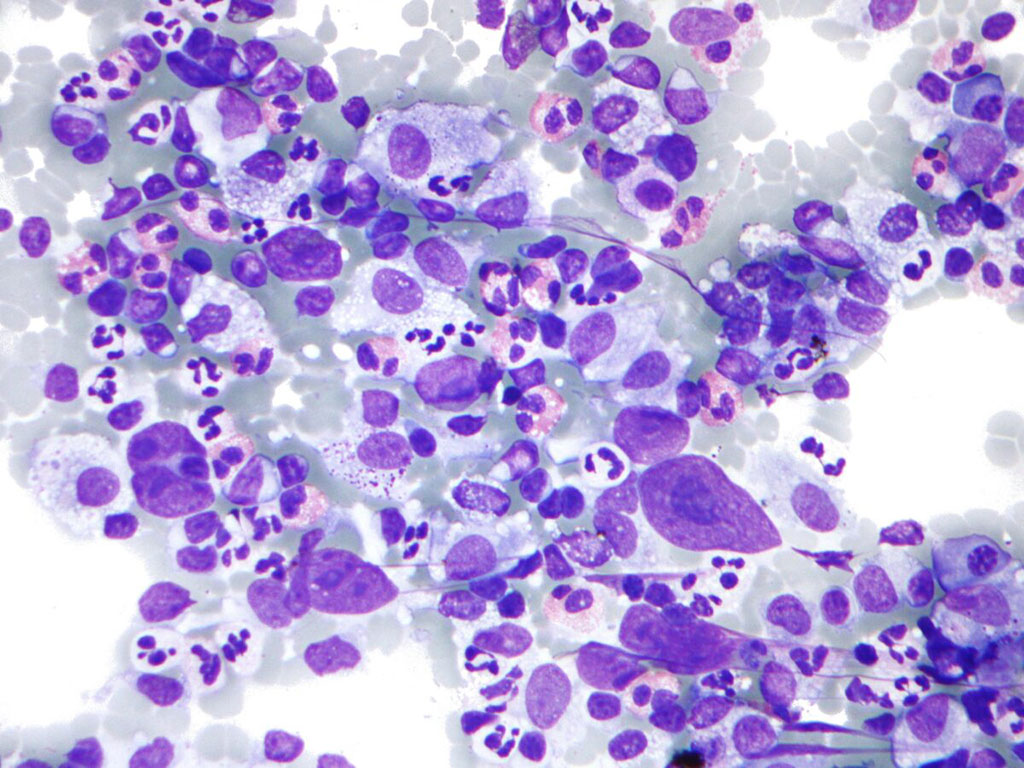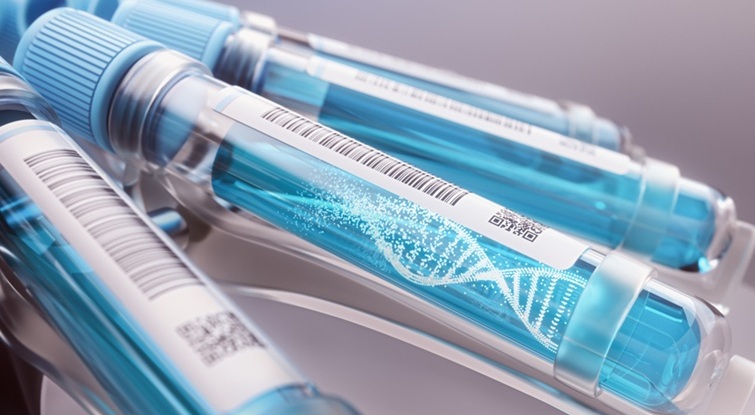Hodgkin Lymphoma Therapy Response Linked to T-Cell Receptor Repertoire
|
By LabMedica International staff writers Posted on 27 Aug 2020 |

Image: Photomicrograph of Hodgkin lymphoma (HL), from a fine needle aspiration of a lymph node, which shows a mixture of cells common in HL: Eosinophils, Reed-Sternberg cells, Plasma cells, and Histocytes (Photo courtesy of Nephron).
Hodgkin lymphoma (HL) is a type of lymphoma in which cancer originates from a specific type of white blood cells called lymphocytes. Symptoms may include fever, night sweats, and weight loss. Often there will be non-painful enlarged lymph nodes in the neck, under the arm, or in the groin.
Hodgkin lymphoma may be treated with chemotherapy, radiation therapy, and stem cell transplant. The choice of treatment often depends on how advanced the cancer has become and whether or not it has favorable features. In early disease, a cure is often possible. PD-1 blockade is highly effective in classical Hodgkin lymphomas (cHLs), which exhibit frequent copy-number gains of CD274 (PD-L1) and PDC1LG2 (PD-L2) on chromosome 9p24.1.
A team of medical oncologists collaborating with the Dana-Farber Cancer Institute (Boston, MA, USA) used T cell receptor (TCR) sequencing and cytometry by time-of-flight (CyTOF) analysis to obtain a peripheral immune signature of responsiveness to PD-1 blockade in 56 patients treated with nivolumab in the CheckMate 205 phase II clinical trial. The TCR sequences for the study were processed through the immunoSEQ platform (Adaptive Biotechnologies, Seattle, WA, USA).
The scientists reported that anti-PD-1 therapy was most effective in patients with a diverse baseline TCR repertoire and an associated expansion of singleton clones during treatment. They also noted that CD4+ TCR diversity significantly increased during therapy, most prominently in patients who had achieved complete responses, but did not make the same observation for CD8+ TCR diversity. Further, the scientists said, patients who responded to therapy had an increased abundance of activated natural killer (NK) cells and a newly identified subset of CD3- CD68+ CD4+ GrB+ cells.
The investigators also found the trial patients had no significant differences in ratios of input CD4+ and CD8+ T cells or total detected CD4+ and CD8+ TCR sequences at baseline, but that peripheral CD4+ TCR repertoire diversity was significantly higher in healthy donors than in patients with newly diagnosed or relapsed or refractory cHL. While baseline CD4+ TCR diversity was not significantly different in newly diagnosed patients and those with relapsed or refractory disease who had complete responses to nivolumab, it was significantly lower in patients with partial responses or progressive disease. They saw similar patterns in baseline CD8+ TCR diversity.
The authors concluded that their studies highlighted the roles of recently expanded, clonally diverse CD4+ T cells and innate effectors in the efficacy of PD-1 blockade in cHL. The study was published on August 10, 2020 in the journal Nature Medicine.
Related Links:
Dana-Farber Cancer Institute
Adaptive Biotechnologies
Hodgkin lymphoma may be treated with chemotherapy, radiation therapy, and stem cell transplant. The choice of treatment often depends on how advanced the cancer has become and whether or not it has favorable features. In early disease, a cure is often possible. PD-1 blockade is highly effective in classical Hodgkin lymphomas (cHLs), which exhibit frequent copy-number gains of CD274 (PD-L1) and PDC1LG2 (PD-L2) on chromosome 9p24.1.
A team of medical oncologists collaborating with the Dana-Farber Cancer Institute (Boston, MA, USA) used T cell receptor (TCR) sequencing and cytometry by time-of-flight (CyTOF) analysis to obtain a peripheral immune signature of responsiveness to PD-1 blockade in 56 patients treated with nivolumab in the CheckMate 205 phase II clinical trial. The TCR sequences for the study were processed through the immunoSEQ platform (Adaptive Biotechnologies, Seattle, WA, USA).
The scientists reported that anti-PD-1 therapy was most effective in patients with a diverse baseline TCR repertoire and an associated expansion of singleton clones during treatment. They also noted that CD4+ TCR diversity significantly increased during therapy, most prominently in patients who had achieved complete responses, but did not make the same observation for CD8+ TCR diversity. Further, the scientists said, patients who responded to therapy had an increased abundance of activated natural killer (NK) cells and a newly identified subset of CD3- CD68+ CD4+ GrB+ cells.
The investigators also found the trial patients had no significant differences in ratios of input CD4+ and CD8+ T cells or total detected CD4+ and CD8+ TCR sequences at baseline, but that peripheral CD4+ TCR repertoire diversity was significantly higher in healthy donors than in patients with newly diagnosed or relapsed or refractory cHL. While baseline CD4+ TCR diversity was not significantly different in newly diagnosed patients and those with relapsed or refractory disease who had complete responses to nivolumab, it was significantly lower in patients with partial responses or progressive disease. They saw similar patterns in baseline CD8+ TCR diversity.
The authors concluded that their studies highlighted the roles of recently expanded, clonally diverse CD4+ T cells and innate effectors in the efficacy of PD-1 blockade in cHL. The study was published on August 10, 2020 in the journal Nature Medicine.
Related Links:
Dana-Farber Cancer Institute
Adaptive Biotechnologies
Latest Immunology News
- Ultrasensitive Liquid Biopsy Demonstrates Efficacy in Predicting Immunotherapy Response
- Blood Test Could Identify Colon Cancer Patients to Benefit from NSAIDs
- Blood Test Could Detect Adverse Immunotherapy Effects
- Routine Blood Test Can Predict Who Benefits Most from CAR T-Cell Therapy
- New Test Distinguishes Vaccine-Induced False Positives from Active HIV Infection
- Gene Signature Test Predicts Response to Key Breast Cancer Treatment
- Chip Captures Cancer Cells from Blood to Help Select Right Breast Cancer Treatment
- Blood-Based Liquid Biopsy Model Analyzes Immunotherapy Effectiveness
- Signature Genes Predict T-Cell Expansion in Cancer Immunotherapy
- Molecular Microscope Diagnostic System Assesses Lung Transplant Rejection
- Blood Test Tracks Treatment Resistance in High-Grade Serous Ovarian Cancer
- Luminescent Probe Measures Immune Cell Activity in Real Time
- Blood-Based Immune Cell Signatures Could Guide Treatment Decisions for Critically Ill Patients
- Novel Tool Predicts Most Effective Multiple Sclerosis Medication for Patients
- Companion Diagnostic Test for CRC Patients Identifies Eligible Treatment Population
- Novel Tool Uses Deep Learning for Precision Cancer Therapy
Channels
Clinical Chemistry
view channel
Compact Raman Imaging System Detects Subtle Tumor Signals
Accurate cancer diagnosis often depends on labor-intensive tissue staining and expert pathological review, which can delay results and limit access to rapid screening. These conventional methods also make... Read more
Noninvasive Blood-Glucose Monitoring to Replace Finger Pricks for Diabetics
People with diabetes often need to measure their blood glucose multiple times a day, most commonly through finger-prick blood tests or implanted sensors. These methods can be painful, inconvenient, and... Read moreMolecular Diagnostics
view channel
Urine Test Could Reveal Real Age and Life Span
Chronological age does not always reflect how quickly the body is aging, as biological age is shaped by genetics, stress, sleep, nutrition, and lifestyle factors such as smoking. A higher biological age... Read more
Genomic Test Identifies African Americans at Risk for Early Prostate Cancer Recurrence
Prostate cancer is one of the most commonly diagnosed cancers in men and a leading cause of cancer-related death, particularly in the United States. African American men face a disproportionately higher... Read moreImmunology
view channel
Ultrasensitive Liquid Biopsy Demonstrates Efficacy in Predicting Immunotherapy Response
Immunotherapy has transformed cancer treatment, but only a small proportion of patients experience lasting benefit, with response rates often remaining between 10% and 20%. Clinicians currently lack reliable... Read more
Blood Test Could Identify Colon Cancer Patients to Benefit from NSAIDs
Colon cancer remains a major cause of cancer-related illness, with many patients facing relapse even after surgery and chemotherapy. Up to 40% of people with stage III disease experience recurrence, highlighting... Read moreMicrobiology
view channel
New UTI Diagnosis Method Delivers Antibiotic Resistance Results 24 Hours Earlier
Urinary tract infections affect around 152 million people every year, making them one of the most common bacterial infections worldwide. In routine medical practice, diagnosis often relies on rapid urine... Read more
Breakthroughs in Microbial Analysis to Enhance Disease Prediction
Microorganisms shape human health, ecosystems, and the planet’s climate, yet identifying them and understanding how they are related remains a major scientific challenge. Even with modern DNA sequencing,... Read morePathology
view channel
Genetics and AI Improve Diagnosis of Aortic Stenosis
Aortic stenosis is a progressive narrowing of the aortic valve that restricts blood flow from the heart and can be fatal if left untreated. There are currently no medical therapies that can prevent or... Read more
AI Tool Simultaneously Identifies Genetic Mutations and Disease Type
Interpreting genetic test results remains a major challenge in modern medicine, particularly for rare and complex diseases. While existing tools can indicate whether a genetic mutation is harmful, they... Read more
Rapid Low-Cost Tests Can Prevent Child Deaths from Contaminated Medicinal Syrups
Medicinal syrups contaminated with toxic chemicals have caused the deaths of hundreds of children worldwide, exposing a critical gap in how these products are tested before reaching patients.... Read more
Tumor Signals in Saliva and Blood Enable Non-Invasive Monitoring of Head and Neck Cancer
Head and neck cancers are among the most aggressive malignancies worldwide, with nearly 900,000 new cases diagnosed each year. Monitoring these cancers for recurrence or relapse typically relies on tissue... Read moreTechnology
view channel
Pioneering Blood Test Detects Lung Cancer Using Infrared Imaging
Detecting cancer early and tracking how it responds to treatment remains a major challenge, particularly when cancer cells are present in extremely low numbers in the bloodstream. Circulating tumor cells... Read more
AI Predicts Colorectal Cancer Survival Using Clinical and Molecular Features
Colorectal cancer is one of the most common and deadly cancers worldwide, and accurately predicting patient survival remains a major clinical challenge. Traditional prognostic tools often rely on either... Read moreIndustry
view channel
BD and Penn Institute Collaborate to Advance Immunotherapy through Flow Cytometry
BD (Becton, Dickinson and Company, Franklin Lakes, NJ, USA) has entered into a strategic collaboration with the Institute for Immunology and Immune Health (I3H, Philadelphia, PA, USA) at the University... Read more





















